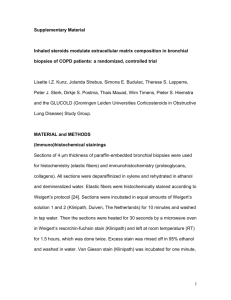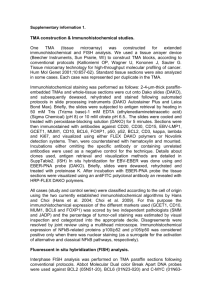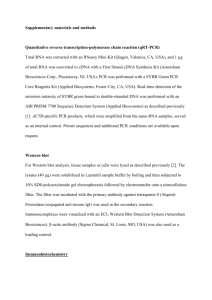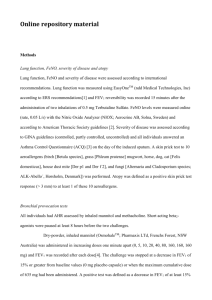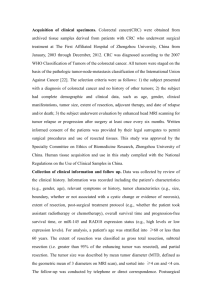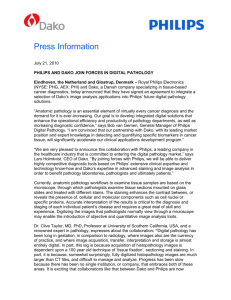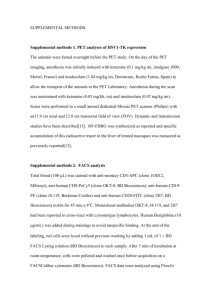Supplemental Information: Immunohistochemistry analysis of
advertisement
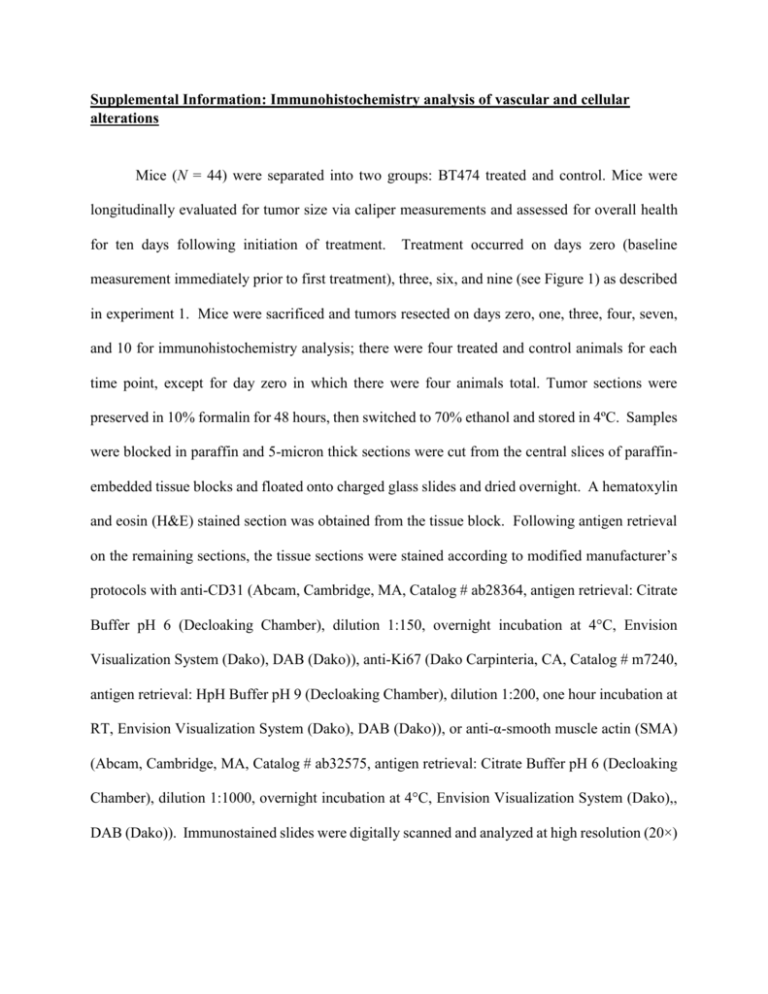
Supplemental Information: Immunohistochemistry analysis of vascular and cellular alterations Mice (N = 44) were separated into two groups: BT474 treated and control. Mice were longitudinally evaluated for tumor size via caliper measurements and assessed for overall health for ten days following initiation of treatment. Treatment occurred on days zero (baseline measurement immediately prior to first treatment), three, six, and nine (see Figure 1) as described in experiment 1. Mice were sacrificed and tumors resected on days zero, one, three, four, seven, and 10 for immunohistochemistry analysis; there were four treated and control animals for each time point, except for day zero in which there were four animals total. Tumor sections were preserved in 10% formalin for 48 hours, then switched to 70% ethanol and stored in 4ºC. Samples were blocked in paraffin and 5-micron thick sections were cut from the central slices of paraffinembedded tissue blocks and floated onto charged glass slides and dried overnight. A hematoxylin and eosin (H&E) stained section was obtained from the tissue block. Following antigen retrieval on the remaining sections, the tissue sections were stained according to modified manufacturer’s protocols with anti-CD31 (Abcam, Cambridge, MA, Catalog # ab28364, antigen retrieval: Citrate Buffer pH 6 (Decloaking Chamber), dilution 1:150, overnight incubation at 4°C, Envision Visualization System (Dako), DAB (Dako)), anti-Ki67 (Dako Carpinteria, CA, Catalog # m7240, antigen retrieval: HpH Buffer pH 9 (Decloaking Chamber), dilution 1:200, one hour incubation at RT, Envision Visualization System (Dako), DAB (Dako)), or anti-α-smooth muscle actin (SMA) (Abcam, Cambridge, MA, Catalog # ab32575, antigen retrieval: Citrate Buffer pH 6 (Decloaking Chamber), dilution 1:1000, overnight incubation at 4°C, Envision Visualization System (Dako),, DAB (Dako)). Immunostained slides were digitally scanned and analyzed at high resolution (20×) in brightfield with a Leica SCN400 Slide Scanner (Leica Microsystems Inc, Ariol, Buffalo Grove, IL). H&E sections were utilized to identify viable regions of tissue. Between five and 34 (depending on the total area of viable tissue) 500 µm2 regions-of-interest (ROIs) were selected to cover the total viable tissue in each tumor to ensure representation of the entire cross-sectional area. The software associated with the Leica SCN400 package provides unbiased, automated image analysis and quantification of immunostaining in brightfield based on stain color, intensity, and shape. For each individual tumor, the Ki67, CD31, and α-SMA stained sections were manually aligned to their respective corresponding H&E slide. The program was trained to automatically segment tissue patterns from known positive tissue samples for each stain through minimal fine manual adjustments to establish thresholds for use in subsequent microvessel, proliferation, endothelial cell coverage, and nuclei quantification. The viable tissue regions were identified in the H&E slides based on color thresholding of necrotic regions and these ROIs were automatically copied and linked to the corresponding Ki67, CD31, and α-SMA slides to ensure comparable regions of tissue were analyzed for all histology quantification. Once trained, the software was applied to the histological data sets and quantified as follows. Microvessel density (MVD) was examined through analysis of CD31 staining and quantified as the total microvessels per area in each ROI. Utilizing the same ROI, coverage of α-SMA stained endothelial cells was calculated. A “vessel maturation index” (VMI) was calculated as the fraction of α-SMA stained vessels compared to total CD31 stained vessels; similar to previous studies analyzing bevacizumabinduced normalization [1]. Quantification of cell proliferation (Ki67 staining) was calculated as the percentage of positive stained nuclei per total nuclei detected within the viable tissue regions of the tumor. REFERNCES 1. Vangestel C, Van de Wiele C, Van Damme N, Staelens S, Pauwels P, Reutelingsperger CP, Peeters M (2011) (99)mTc-(CO)(3) His-annexin A5 micro-SPECT demonstrates increased cell death by irinotecan during the vascular normalization window caused by bevacizumab. Journal of nuclear medicine : official publication, Society of Nuclear Medicine 52 (11):1786-1794.
